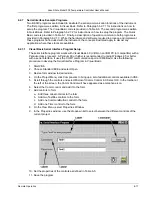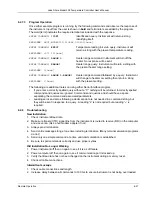
Lake Shore Model 332 Temperature Controller User’s Manual
6.2
SERIAL INTERFACE OVERVIEW
The serial interface used in the Model 332 is commonly referred to as an RS-232C interface. RS-232C
is a standard of the Electronics Industries Association (EIA) that describes one of the most common
interfaces between computers and electronic equipment. The RS-232C standard is quite flexible and
allows many different configurations. However, any two devices claiming RS-232C compatibility cannot
necessarily be plugged together without interface setup. The remainder of this paragraph briefly
describes the key features of a serial interface that are supported by the instrument. A customer
supplied computer with similarly configured interface port is required to enable communication.
6.2.1 Physical
Connection
The Model 332 has a 9 pin D-Subminiature plug on the rear panel for serial communication. The
original RS-232C standard specifies 25 pins but both 9- and 25-pin connectors are commonly used in
the computer industry. Many third party cables exist for connecting the instrument to computers with
either 9- or 25-pin connectors. Paragraph 8.4.1 gives the most common pin assignments for 9- and
25-pin connectors. Please note that not all pins or functions are supported by the Model 332.
The instrument serial connector is the plug half of a mating pair and must be matched with a socket
on the cable. If a cable has the correct wiring configuration but also has a plug end, a “gender
changer” can be used to mate two plug ends together.
The letters DTE near the interface connector stand for Data Terminal Equipment and indicate the pin
connection of the directional pins such as transmit data (TD) and receive data (RD). Equipment with
Data Communications Equipment (DCE) wiring can be connected to the instrument with a straight
through cable. As an example, Pin 3 of the DTE connector holds the transmit line and Pin 3 of the
DCE connector holds the receive line so the functions complement.
It is likely both pieces of equipment are wired in the DTE configuration. In this case Pin 3 on one DTE
connector (used for transmit) must be wired to Pin 2 on the other (used for receive). Cables that swap
the complementing lines are called null modem cables and must be used between two DTE wired
devices. Null modem adapters are also available for use with straight through cables. Paragraph
8.4.1 illustrates suggested cables that can be used between the instrument and common computers.
The instrument uses drivers to generate the transmission voltage levels required by the RS-232C
standard. These voltages are considered safe under normal operating conditions because of their
relatively low voltage and current limits. The drivers are designed to work with cables up to 50 feet in
length.
6.2.2 Hardware
Support
The Model 332 interface hardware supports the following features. Asynchronous timing is used for
the individual bit data within a character. This timing requires start and stop bits as part of each
character so the transmitter and receiver can resynchronized between each character. Half duplex
transmission allows the instrument to be either a transmitter or a receiver of data but not at the same
time. Communication speeds of 300, 1200 or 9600 Baud are supported. The Baud rate is the only
interface parameter that can be changed by the user.
Hardware handshaking is not supported by the instrument. Handshaking is often used to guarantee
that data message strings do not collide and that no data is transmitted before the receiver is ready.
In this instrument appropriate software timing substitutes for hardware handshaking. User programs
must take full responsibility for flow control and timing as described in Paragraph 6.2.5.
6-14
Remote Operation















































